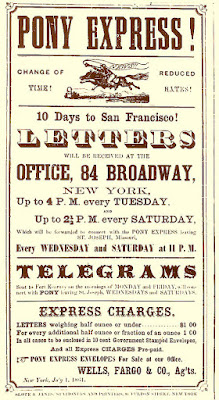From the time the Pony Express was
founded, people admired the speed with which it delivered mail in the West. The
service gained a stellar reputation, often bordering on mythical. Perhaps that’s
why it shows up in numerous novels, even some set in times when the Pony
Express was no longer in business.
The Pony Express actually operated for
only eighteen months, from April 3, 1860 to October 26, 1861, although service
continued into November until all the mail in the agency’s possession on the
closure date had been delivered.
Before the telegraph and the transcontinental railroad, letters from the Midwest sent by stagecoach could take nearly a month to reach the west coast. If sent by ship, delivery could take several months. The Pony Express could carry mail from St. Joseph, Missouri to Sacramento, California in an average of ten days.
 |
| Pony Express Route - Library of Congress |
In order to attain this speed of delivery,
the founders of this service—William Russell, Alexander Majors, and William B.
Waddell—established a series of nearly 200 stations, approximately ten miles
apart, across the current states of Missouri, Kansas, Nebraska, Colorado,
Wyoming, Utah, Nevada, and California. A rider generally changed horses at
every station along his 75-100 mile route to make sure the steeds were fresh
and could travel as fast as possible. Although the service was called “Pony”
Express, most of the mounts were actually horses. The preponderance of the
approximately 400 horses involved in the enterprise were half-breed mustangs
(referred to as “California horses”), Thoroughbreds and Morgans.
The main goal of the Pony Express was
speed, so great pains were taken to keep the weight the horses had to carry to
a minimum. Most riders were small, wiry and thin, weighing between 100 and 125
pounds. Their average age was about 20. Many teenagers, some as young as
fourteen, were employed. To further minimize weight, they wore close-fitting
clothes. It is unlikely that they wore wide-brimmed cowboy hats, even though
riders were frequently depicted with them. At any given time, a total of
approximately 80 riders could be on the route, including those going east and
those going west.
 |
| This logo illustrates the special saddlebags. |
Special bags called mochilas were designed
to minimize weight and expedite horse and rider changes. The mochila had a
leather cover that fit over the saddle with four padlocked pockets beneath it.
The rider sat on the leather with a mail pouch on either side of each leg. This
special saddlebag could carry a total of twenty pounds, which was a significant
amount of mail since most of it was written on very thin paper.
Pony Express riders were required to swear
an oath to the company, in which they pledged in part: "I will, under no circumstances, use profane
language, that I will drink no intoxicating liquors, that I will not quarrel or
fight with any other employee of the firm, and that in every respect I will
conduct myself honestly, be faithful to my duties, and so direct all my acts as
to win the confidence of my employers, so help me God." Riders who broke
their oath risked being dismissed without pay.
Co-founder Alexander Majors gave each rider a leather-bound Bible and
asked that he keep it with him. Most likely, riders ignored him as the books
would have added weight thus compromising the effort to maximize speed.
 |
| via Wikimedia Commons |
Sending a letter via the Pony Express was
an expensive proposition, another incentive for using thin paper. The company
initially charged $5.00 per half-ounce for each item sent. (That is more than
$130 in today’s money.) Even when the price was later reduced to $1.00 per
half-ounce, the cost was still too high for ordinary people to afford. Most of
the material transported by the riders was made up of government dispatches,
business documents and time-sensitive newspaper reports.
Despite the high prices they charged, the
Pony Express was a financial disaster. According to the Smithsonian Postal
Museum, the owners of the fastest mail carrying company in the country lost $30
for every letter they carried because they were not able to win a government mail
contract. They had lost approximately $200,000 by the time the service ended,
two days after Western Union completed the transcontinental telegraph line.
Buy Links: Paperback at Amazon Amazon print or digital



Really interesting, Ann. Never knew the Pony Express only ran for 18 months. Pity about their costs - it would be too pricey for most people. Given their need for small, light riders, I wonder if any women were part of the Express?
ReplyDeleteThanks, Lindsay. I couldn't find any record of a woman serving as a pony express rider. In that era, we know of women who dressed as men to fight in our Civil War, so who knows?
DeleteReally interesting post. I had no idea the costs were so high in real terms, but I can see why they would be with such an expansive infrastructure.
ReplyDeleteThanks for you comment, I hadn't really thought about the costs of running the operation either until I started researching.
Delete